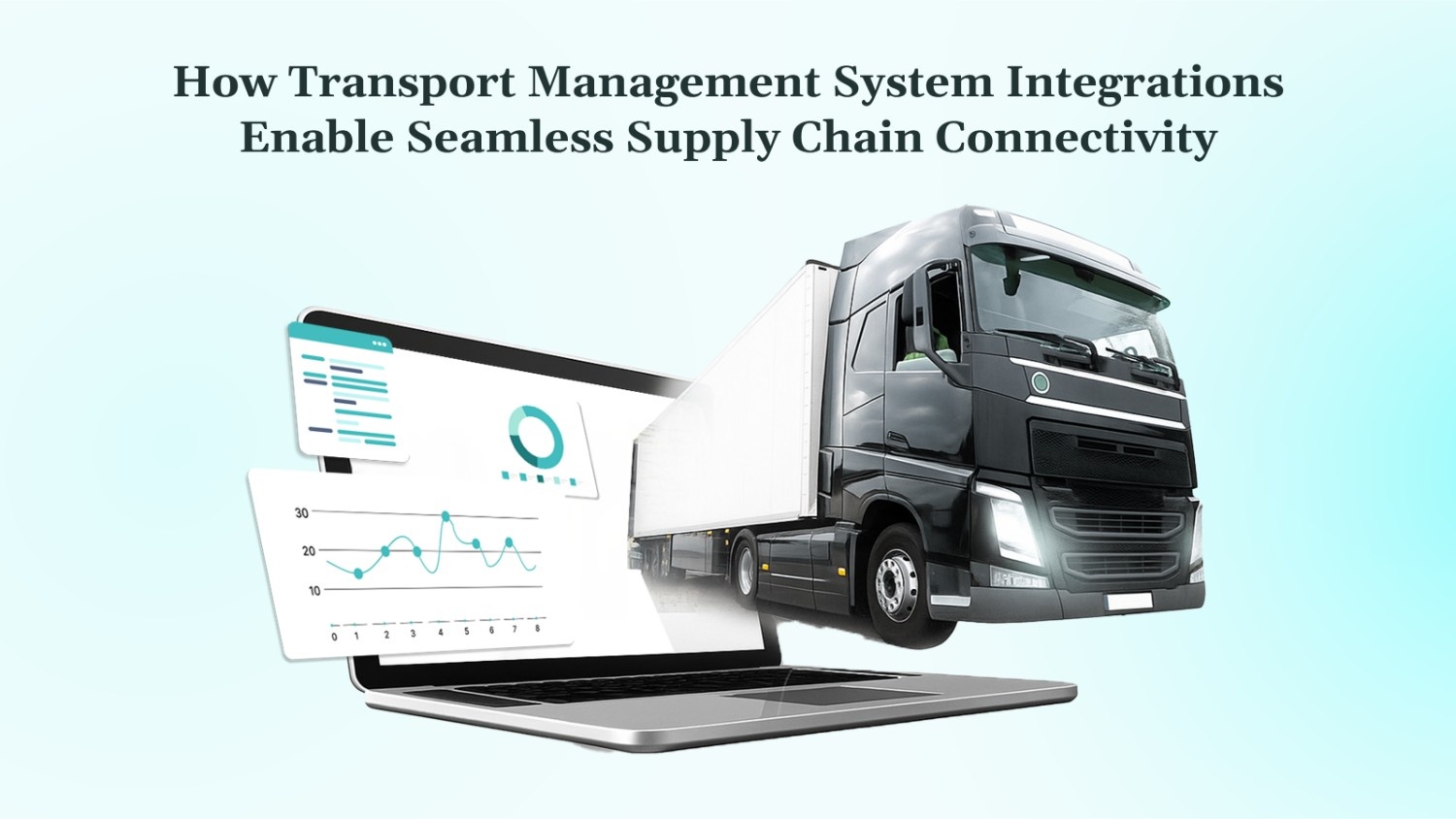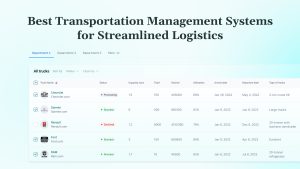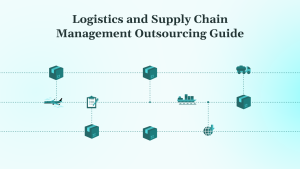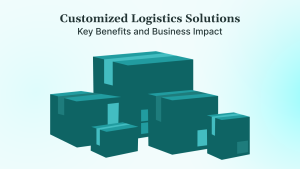The global TMS market is set to grow from $16.0 billion in 2024 to $40.3 billion by 2029, at a CAGR of 20.2%. That massive growth reflects the rising demand for integrated, automated ecosystems that streamline operations across carriers, warehouses, billing, and customer support.
We understand that integrating multiple complex systems like TMS, WMS, ERP, and carriers can feel overwhelming and technically challenging for logistics teams striving to maintain seamless operations.
Modern logistics, thus, greatly depends on systems that communicate seamlessly. Integrating a TMS with other critical software like WMS, ERP, carriers, and CRM transforms fragmented tools into a unified ecosystem. This creates visibility, reduces errors, and speeds decision-making.
You will learn which systems to connect, the key benefits, common pitfalls, and best practices for successful implementation. Let us start by understanding why integration for the transport management system matters.
Key Takeaways
- TMS integration connects core systems like warehouse, ERP, and carrier APIs for data consistency and control.
- The central systems to integrate include WMS, ERP, carriers, CRM, billing, and eCommerce.
- Integrations deliver real-time visibility, operational efficiency, cost reduction, and agile scalability.
- Best results come from API-first design, health monitoring, and phased rollouts.
- For complex projects, DEVtrust offers system orchestration, connector engineering, and scalable integration support.
Why Does Integration for Transport Management System Matter?
TMS integration turns scattered systems into a cohesive logistics ecosystem. It connects warehouses, carriers, financial systems, and customer platforms, allowing organizations to operate faster, smarter, and with fewer errors. A tightly integrated TMS reduces manual work, brings reliable data, and supports real-time decision-making.
Integrated systems deliver continuous visibility. When your TMS and WMS share data, you see exactly when orders are staged, loaded, and dispatched. This real-time insight enables proactive planning and rapid response to delays or changes in demand.
Automation lies at the heart of effective integration. Your TMS can automatically tender freight, update shipment statuses, and sync billing data with no manual intervention. This reduces errors, accelerates processes, and frees teams to focus on higher-value tasks.
Ultimately, integration enhances control and scalability. Whether you are adding new carriers, expanding fulfillment centers, or handling peak volumes, connected systems ensure reliable workflows. You gain the operational agility needed to evolve without rebuilding from scratch. So, which systems can you integrate with your TMS?
Key Systems To Integrate With Your TMS
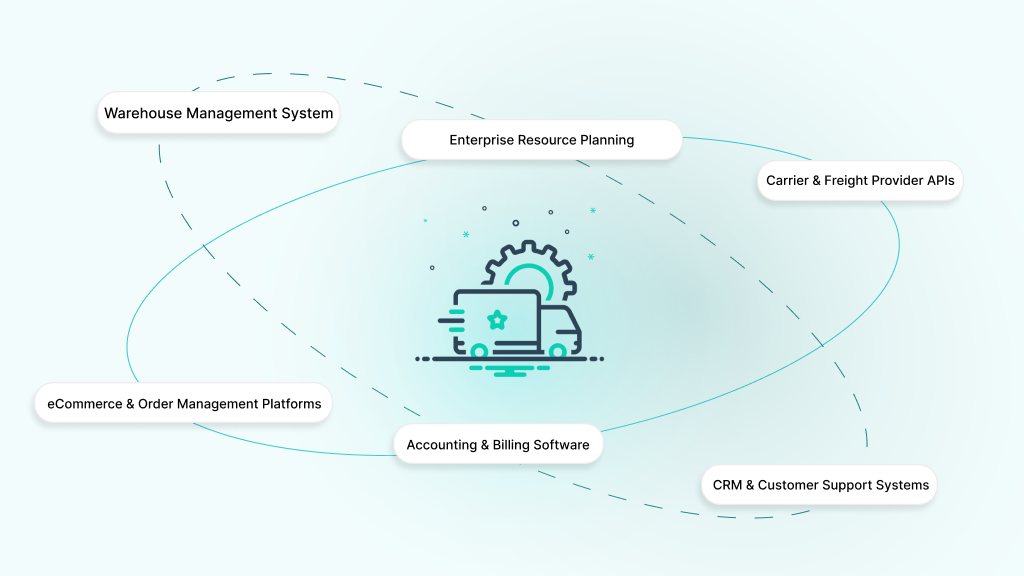
A Transport Management System (TMS) becomes truly powerful when combined with integrations that create a seamless logistics ecosystem.
Connecting your TMS with core systems like WMS, ERP, CRM, carriers, billing, and eCommerce platforms enables smoother workflows, accurate data, and smarter operations. Each integration layer amplifies efficiency, visibility, and control across your logistics network.
Warehouse Management System (WMS)
Integrating TMS with WMS ensures tight coordination between warehouse operations and transport execution. When orders are staged or packed in a warehouse, that real-time status feeds directly into the TMS.
This enables load optimization and route scheduling based on actual readiness, not estimates. Businesses combining WMS and TMS see significant improvements in delivery accuracy and workflow efficiency.
Detailed staging information reduces misloads and delays. Logistics teams avoid spreadsheets and manual updates, and warehouse staff plan loading schedules more effectively. The result is faster dispatch, fewer errors, and better alignment between warehouse output and transportation demand.
Enterprise Resource Planning (ERP)
ERP–TMS integration harmonizes financial, order, and inventory data across your organization. Order details flow from ERP into the TMS; once shipments are dispatched, the TMS updates cost and delivery status back into ERP. That drives accurate billing, inventory updates, and revenue forecasting.
A unified system eliminates discrepancies and improves cash visibility. Real-time synchronization architectures powered by service-oriented architecture and messaging queues enable continuous, bidirectional ERP–TMS data exchange.
Carrier & Freight Provider APIs
Modern logistics demands real-time rate quotes, automated booking, and shipment tracking. Direct API integrations with carriers bypass manual and third-party delays. These APIs support rate comparison, tendering, and status updates, without manual inputs or intermediaries.
API-enabled integrations empower dynamic pricing logic, frequent routing updates, and more predictable delivery performance. Carriers with resilient APIs minimize latency and errors, improving service consistency across high-volume shipments. Read how DEVtrust helped Draydex develop a rate management system in the context of the freight industry.
CRM & Customer Support Systems
Shipping data is not just valuable for ops teams; it drives customer satisfaction, too. Integrating TMS with CRM systems ensures that delivery updates, exception alerts, and ETAs are visible to support agents in real time. This reduces inquiry resolution time, avoids ticket transfers, and improves customer experience.
Direct TMS-to-CRM links mean support teams no longer rely on delayed or manual logs. Frontline agents can respond with confidence and clarity, backed by live logistics data.
Accounting & Billing Software
Transport workflows often involve complex invoices, rate changes, and surcharges. Direct integration between TMS and your accounting system automates carrier invoice matching, approvals, and ledger entries. It reduces reconciliation time and eliminates manual errors.
This financial integration streamlines audit trails and improves visibility into billing cycles. This is a critical necessity for companies scaling logistics operations across geographies.
eCommerce & Order Management Platforms
When customer orders originate online, integration with eCommerce or Order Management Platforms ensures seamless handoffs into logistics. Order status, shipping method, and delivery details flow directly into TMS workflows, enabling prompt route planning.
This interconnected pathway supports faster fulfillment, accurate delivery commitments, and unified shipment statuses. It also works to improve customer experience and reduce processing delays.
Integration between your TMS and six critical systems forms a comprehensive connectivity layer. It saves time, minimizes errors, delivers transparency, and supports growth, transforming supply chain operations from reactive to proactive control.
The following section explores how integration yields real business benefits in performance and cost. Moving on, we have the benefits of TMS integrations.
Benefits Of TMS Integrations
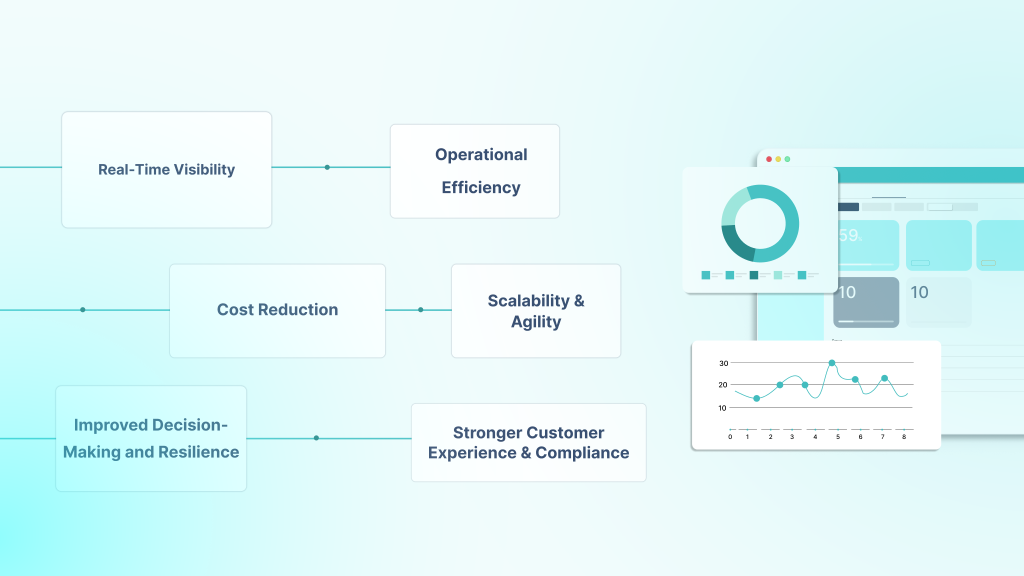
Integration is the force multiplier for your Transport Management System (TMS). When systems share data seamlessly, like TMS, WMS, ERP, carriers, CRM, billing, and eCommerce, you get a logistics nerve center. Below are expanded explanations of the core benefits, supported by research and industry reports.
Real-Time Visibility
Integrated systems unlock complete transparency across the supply chain. When TMS connects with WMS, carriers, and ERP, teams gain live updates on inventory levels, staging status, shipment progress, and delivery locations.
This visibility breaks silos and supports rapid decisions to reroute shipments, resolve delays, or optimize loading. Rising demand for real-time visibility is a key factor driving annual growth in the TMS market in the coming years.
Operational Efficiency
A connected logistics stack eliminates manual handoffs and redundant data entries. TMS integrations automate capacities like tendering, dispatch, status updates, and financial data syncing. Operations teams move from firefighting to workflows that run smoothly.
Companies leveraging integrated TMS systems reduce transportation costs, thanks to automation and coordinated workflows. Learn how DEVtrust enhanced Moveit4U’s TMS with job customization and management integrations, boosting operational efficiency.
Cost Reduction
Thoughtful planning and tight integration pay off financially. By combining carrier rate quotes, inventory levels, and dispatch information, organizations can optimize routes, consolidate loads, and avoid billing discrepancies.
CSCMP-backed research shows firms implementing end-to-end TMS integration also see boosts in delivery performance and invoice accuracy, directly influencing margins.
Scalability & Agility
Integrated logistics systems are not brittle; they evolve. With API-first architectures, new carriers, fulfillment centers, or digital sales channels can be added without disrupting operations.
Real-time connections prevent delays, data mismatch, or manual touchpoints during scaling. Firms that adopt TMS gain both flexibility and capacity once integration is complete.
Improved Decision-Making and Resilience
An integrated TMS stack enhances insight into supply and transport trends. Embedded analytics show bottlenecks, cost drains, and exceptions.
Leaders can act on those insights proactively. Real-time tracking and predictive analytics, enabled through integrated TMS, allow better disruption planning, routing flexibility, and consistent service quality.
More substantial Customer Experience & Compliance
Customer satisfaction improves when systems sync. CRM teams get visibility into shipping updates, ETAs, and issue alerts, all without manual data lookups.
Compliance tracking for invoices, delivery logs, and carrier performance becomes automated. That means fewer disputes, faster resolution, and better support, all supported by system-to-system data exchange.
These integration advantages, from clarity and coordination to cost savings and scalability, are foundational to modern logistics performance.
When your TMS shares timely, accurate data with your ecosystem, you gain visibility, control, and responsiveness across operations. Companies may face some common challenges in integration with TMS. Let’s see how they are overcome.
Common Challenges in Integration for TMS and How to Overcome Them
Integrating a Transportation Management System (TMS) with other software brings significant efficiency gains. However, it also comes with obstacles. Identifying these challenges early and preparing strategies to resolve them ensures a smoother, more effective deployment.
Data Mapping Inconsistencies
When integrating systems like ERP, WMS, and carrier APIs, mismatches in data formats and field definitions are common. As research shows, up to 74% of integration failures stem from inconsistent data standards or faulty mappings between systems.
The fix begins with defining explicit, standardized data schemas and careful mapping of fields across systems. Middleware solutions or integration platforms help mediate data transformation. This upfront discipline prevents mismatched entries and ensures all systems speak a common data language.
API Version Changes & Deprecation
APIs evolve. External providers may update or deprecate endpoints without warning. Without proper version management, integrations can stop working unexpectedly. Enterprise integration frameworks stress the need to plan for API lifecycle shifts and ensure fallback compatibility mechanisms.
Maintain explicit versioning, subscribe to API change notifications, and layer in middleware that can abstract or buffer API shifts. These measures keep your integration stable, even when external systems evolve.
Error Handling Across Systems
When data fails to flow or causes exceptions, integrations can silently break, disrupting logistics execution. Effective error management includes automatic retries, reconciliation jobs, and real-time alerts to operations teams.
As enterprise studies note, a lack of clear accountability and process oversight is a frequent reason for integration breakdowns. Instrument monitoring dashboards, define alert criteria, and ensure systematic logging so integration issues are detected and resolved quickly.
Latency & Throughput Issues
Real-time logistics depends on timely data exchange. However, too many API calls or extensive batch processes can overload systems, causing delays or downtime. Modern middleware and service-oriented approaches help distribute loads and maintain synchronous operations even under high volume.
Design asynchronous pipelines where appropriate, queue high-volume data transfers, and use scalable message buses or microservices to mitigate bottlenecks during peak demand.
These four challenges are often the root cause of integration failures in logistics ecosystems. A proactive approach can turn integration into a strategic advantage rather than a drag.
Should You Hire a Specialist?

When TMS integration spans multiple systems and APIs, choosing an experienced partner proves essential. While in-house teams may build initial connections, scaling and sustaining integrations demand deep technical skills. DEVtrust offers specialized services to ensure performance, resilience, and future-proofing:
System Design & API Orchestration
DEVtrust architects robust data flows that span WMS, ERP, CRM, billing, and carrier platforms. Their integration designs maintain consistency even when systems evolve, ensuring scalable, modular connectivity.
Connector Development
Building a reliable integration with dozens of carriers requires custom connectors that handle various APIs, EDI, and messaging protocols. DEVtrust engineers these connectors to adapt to diverse systems and edge cases.
Error Monitoring & Support
DEVtrust sets up continuous monitoring and automated alerts for sync issues or data mismatches. This proactive approach minimizes downtime and supports swift response and resolution.
Scalable Architecture
Handling peak shipping times or expanding business lanes demands infrastructure designed for resilience. DEVtrust builds cloud-native, microservice-based systems that scale with demand and maintain performance.
By using a partner like DEVtrust, businesses can move beyond basic integrations to build a unified, scalable logistics ecosystem. You get all of this with architecture, connectors, monitoring, and support for all working in concert for reliable operations.
Conclusion
All systems connected, like TMS, WMS, ERP, carriers, CRM, billing, and storefronts, combine to form a powerful logistics platform. Integration brings clarity, speed, and control across your supply chain. With the best practices and architecture we have covered, you can avoid integration pitfalls, maximize return, and unlock operational agility.
Strong TMS integration, when managed alongside supply chain processes, significantly improves business performance by enhancing supply chain effectiveness. With these insights and a structured approach, you can be equipped to build an adaptable, resilient logistics foundation.
If your logistics ecosystem has multiple systems or growing complexity, get in touch with DEVtrust to explore how they can design and implement seamless integrations.
Integration For Transport Management System: Unlocking Seamless Supply Chain Connectivity
Learn how integrating your TMS with WMS, ERP, carriers, CRM, billing & eCommerce boosts visibility, efficiency, and sets logistic systems up for growth.
Contact Us